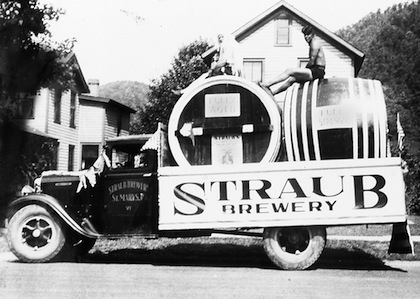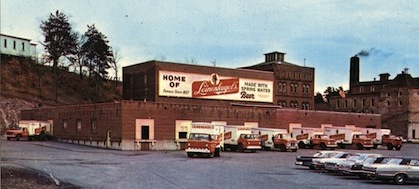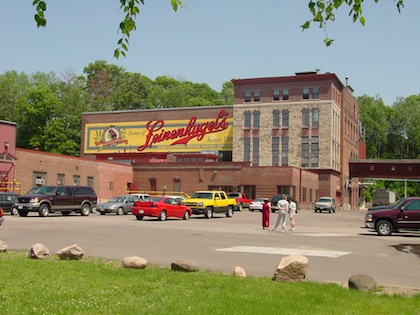Heritage Breweries
Yesterday’s Breweries Have Become Tomorrow’s
“Brewing since 1907.”
For an industry that spends millions to emphasize the freshness of its product, there’s still some attention to be paid to dusty, sepia-shaded history.
“Made in San Francisco since 1896.”
It takes some looking, but if you shuffle through the cooler at your local beer store you’ll find labels that proudly boast of traditions that are seriously old.
“Brewing excellence since 1857”
Not just old as in “your father’s beer.”
“Established in Milwaukee 1844.”
We’re talking old enough to be Abe Lincoln’s father’s beer.
“Since 1829.”
Somehow they’ve survived, through world wars and epidemics how would epidemics affect beer companies?and family rivalries and corporate takeovers and that loathsome low-carb fad. And they continue to thrive, even in an era of shortened attention spans and the newfangled desire for the next newest thing.
These are America’s pre-Prohibition breweries, the ones that were founded before passage of the 18th Amendment and then somehow emerged when we came back to our senses.
You can call them retro or old-fashioned. A decade ago, beer historian Greg Kitsock labeled them as heirloom breweries, a bit of an inaccuracy because most of the survivors have been sold and re-sold so many times, they’re hardly family treasures. More recently, Brewers Association President Charlie Papazian began calling them heritage breweries, another description that implies inheritance.
Maybe that’s the point.
For, even as the owners, the labels and the beer itself may change, the breweries remain the same in our collective consciousness, their familiar brands passed down from one generation of beer drinkers to the next, standing tall and pouring clean. Americans inherit these old beers the same way we receive the shared knowledge of baseball and patriotism.
Consider, for example, Genesee, the Rochester, NY, brewery named for the Seneca Indian word for pleasant valley. Its label proclaims, “One brewery, one great taste, since 1878.”
That’s all very nice… and all very inaccurate:
One brewery? More like 10 or 15. It started with 19th-century immigrant names such as Rau and Reisky and Bartholomay, and grew with the likes of Koch and Shea and Dundee. Today, it makes beer for Blue Point and Narragansett and Labatt, not to mention generic drugstore lager.
One great taste? More like 20 or 30, including everything from hard lemonade to that famous cream ale.
Since 1878? That’s when the Genesee brand name was launched, but the brewery’s true heritage is at least 20 years older, dating to a location just two blocks south of its current facility.
Over the years, the brewery has been sold, closed, reopened and renamed, and with each change came a label re-design. But it matters not a whit for, in a testament to its enduring familiarity, most beer drinkers still refer to the beer as just plain ol’ Genny.
That’s why, in 2011, the current owners found themselves forking over $60,000 to pay for the restoration and relighting of the company’s giant 60-year-old GENESEE BEER sign atop a building in nearby Auburn, NY.
Yes, the sign could’ve been dismantled and no one save a few grumpy preservationists would’ve squawked. And, yes, the company is run by some faceless New York City private investment firm accountable to no one but its shareholders. But even from its 31st-floor offices above Park Avenue, the company understood the value of tradition. So, when a company spokeswoman declared that the sign’s re-lighting “is one way we are showing our continued commitment to our heritage,” everyone applauded.
Granted, that might be little more than a token nod to tradition. But look what happens when a company turns its back on its own history.
In 2009, Iron City Brewing, which had made beer in Pittsburgh since 1861, announced it would auction off its equipment and begin contract brewing out a plant a mere 40 miles away in Latrobe, PA. This is a brand that was so inexorably linked with the people of Pittsburgh, its cans were illustrated with a team photo of the Steelers.
But when the brewery made the move, its once-loyal fans greeted the news with T-shirts that read, “Want an Iron City? Drive to F–king Latrobe.”?
Preserving and honoring the tradition of these old breweries isn’t just benevolent stewardship. It’s actually good for business.
For a decidedly ironic example, look at Miller Brewing Co.
The company was founded in Milwaukee in 1855 by one of America’s early brewing giants, a German immigrant named Frederick Miller. His family would run the company for more than a century, proudly weathering Prohibition and emerging as a brewing powerhouse in the 1950s with one of America’s iconic brands, Miller High Life. Then the company was sold to a chemical manufacturer, which flipped it to a cigarette maker, which unloaded it on a London-based brewing conglomerate, which merged its operations with two of its biggest competitors, Molson and Coors. Today, its biggest seller is Miller Lite, a thoroughly modern brand (triple hops) on whose jazzy vortex bottle you will find not a single mention of the brewery’s history.
A mega-corporation with no regard for heritage? Big surprise.
But then chew on the Jacob Leinenkugel Brewing Co.–a prototypical heritage brewer, a survivor run by the founder’s fifth-generation descendants who produce beer made from 19th-century recipes, proudly labeling its brand as “the Pride of Chippewa Falls, Wisconsin, since 1867.”
And, yep, wholly owned by Miller Brewing.
When Miller acquired Leinenkugel’s in 1988, it transformed the company. In less than 10 years, what had been a quirky brewery serving mainly Wisconsin and Chicago would triple its production and expand its reach throughout the entire nation. It’s tempting to shrug off the brewery as just another corporate cog, except that its president, Jake Leinenkugel, insisted, “We don’t take orders well from the parent company. We do what we think is right for the Leinenkugel family brand.”
That ethos is the product of the most transformative period in American brewing history, a period that “My father called a mode of survival rather than thriving,” Leinenkugel said.
Before World War II, beer was mainly a localized industry. Though pasteurization, refrigeration and improved long-distance transportation had been around since before Prohibition, it was still costly to ship beer from, say, St. Louis to Los Angeles. These so-called shipping breweries had to recoup their costs somehow – and their solution was pure marketing genius—introducing the Premium Beer.
Yes, Budweiser, Pabst, Miller all tasted about the same as, say, Rheingold or Lucky Lager or Neuweiler. But by calling themselves premium, their makers were able to charge a dime more per bottle than the locals.
“The premium image was such a strange phenomenon,” said F. M. Scherer, former chief economist for the Federal Trade Commission who’s written extensively about post-war changes in the beer industry. “It’s all-important, yet it hardly makes any sense.”
Premium beer wouldn’t have shaken up the industry much, except, in Scherer’s words, “some bad stuff happened.”
Starting about 1950, these mainly Midwest shipping breweries began to open new facilities across the country, in California, Texas, New York and the South. That slashed their shipping costs and “suddenly, they have a lot of money to play around with,” said Scherer. “So they advertised like hell to reinforce their premium image.”
And where did they advertise? Television, of course. It was the dawning of nationally televised sporting events–NBC’s baseball “Game of the Week,” “Gillette Cavalcade of sports Friday night fights”–and for the first time large breweries could reach the entire country with a single ad.
A common misperception of the era holds that the big guys simply swallowed up the little fish. In fact, the Justice Department fought most brewery mergers, so the national breweries instead grew from within–a tack that actually sealed the fate of the regionals. With advanced equipment, the big companies could brew beer more cheaply, faster and more efficiently, further increasing profits.
The weaker competition tried to keep up, with more advertising, new products and new blood. But it was too little, too late.
Ballantine, brewing since Martin Van Buren was president, left Newark in 1972. Joseph Schlitz, which had been America’s biggest brewery as recently as 1950, would collapse in 1982. When Christian Schmidt & Son shut down in 1987, it left Philadelphia without a brewery for the first time since the city was founded three centuries earlier.
Falstaff, farewell.
Goebel, gone.
Schaefer, see ya later.
The depth of the transformation was stunning. Consider that Prohibition itself cost the nation about half of its breweries. The 50 years after Prohibition would see the collapse of 85 percent of those survivors.
By 1980, four of every five American beers were manufactured by just six companies.
“There was an enormous shakeout,” said Scherer, now a professor emeritus in the John F. Kennedy School of Government at Harvard University. “It was an all-out shootout.”
Jake Leinenkugel had a front-row seat for bloodshed. Born in 1952, he grew up watching his father hold off the wolves. “Pabst, Budweiser, Miller, even Olympia, Hamm’s, Schmidt, Grain Belt—they all came into our territory,” Leinenkugel said. “Twelve new beers in something like five years. That’s a heck of a wakeup call.”
Like any decent brewer, Leinenkugel credited his company’s quality beer for the company’s survival. But he acknowledged it took more than that. The company built a tour center, sold T-shirts and baseball caps and developed a deep connection with its customers. Then, Leinenkugel said, “we got lucky.” In 1978 Newsweek magazine praised Leinie’s as the best local beer in America, describing it as “a nippy brew perfect for those times when you take a few more pops than is your custom.”
Sales spiked nearly 20 percent.
In retrospect, it appears the Newsweek article and others like it had tapped into a newly re-awakened appreciation for small, regional breweries. As recently as 1973, Chicago Daily News columnist Mike Royko had famously written that most domestic beer tasted like it had been run “through a horse.” But by the end of the decade, baby boomers– still burning over Vietnam and Watergate– would begin rejecting Big Beer in search of more “authentic,” flavorful products..Suddenly, they were discovering brands that had been around for decades: Yuengling (founded 1829), Point (1857), Schell (1860) and, notably, Anchor (1896).
That’s right–it’s worth remembering that the steam brewery Fritz Maytag would use to launch the modern microbrewing revolution was actually built before the start of the 20th century.
Indeed, it’s tempting to think of craft brewing as a recent phenomenon. But from its home in the tiny, northwestern Pennsylvania town of St. Marys, Straub Brewing would like to remind you that it has been “Handcrafted since 1872.”
Straub salesman Paul McGee, who got his start in the business by cleaning out the tanks at Genesee, now spends his workdays repeating that message, one account at a time. “You find your niche,” McGee said. “Bud, Miller, Coors–they’re no longer American-owned. Straub is a Pennsylvania brewery, and we’ve been around for a while.”
For years, Straub made just two styles: Straub and Straub Light. In 2007, it added Peter Straub’s Special Dark. In a small concession to changing times, it recently began offering its beer in cans. Asked if he thought he’d see the day when Straub makes, say, an India pale ale, McGee said, “Doubt it. We’ve got to stay true to our roots… You’ve got to stick to a style that you are comfortable with and stay true to the heritage of your brand.”
Well, that’s one approach.
F.X. Matt in Utica, NY, carved a path in the opposite direction.
One hundred years after it was established in 1888, Matt found itself limping along, unable to out-market, out-advertise or under-price the national brands. Its flagship brand, Utica Club, was languishing. “We had no basis to compete with the big guys,” said Chairman and CEO Nick Matt. “You just couldn’t succeed.”
In 1991, the company took a stunning gamble. Its tiniest brand, called Saranac 1888, had just won a gold medal at the Great American Beer Festival in Denver. At the time, it accounted for less than 1 percent of company sales, but the family-owned company decided to go all-in.
“We said, ‘Gee, if we’ve got this beer that’s been voted the best American lager, maybe we should put our resources behind it,’” Matt said.
The company renamed it Adirondack Lager, and then began adding other styles under the Saranac label. A pale ale, a black-and-tan, a black lager, an Irish stout. Today it has many varieties, and the Saranac line now accounts for more than half of Matt’s sales.
“In hindsight,” Matt said, “it turned out to be one of the greatest decisions our company ever made.”
Other companies noticed.
Leinenkugel, which once made just one basic lager brand, now bottles 15 styles, including the new Big Eddy line that features the likes of a strong Russian imperial stout and a hoppy double IPA.
Schell’s Brewing of New Ulm, MN, (established 1860) has grown to 17 varieties, including the old Grain Belt brands.
And the 154-year-old Stevens Point brewery in Wisconsin is up to about 20, including such decidedly non-traditional oddballs as pumpkin, raspberry and an IPA with six different hop varieties.
“We still play off of our history, in terms of tradition,” said Joe Martino, who has been operating partner of Stevens Point since 2007. “But most importantly, our beers have to be relevant.” That explains how a brewery founded in the midst of the tight-laced Victorian era now makes a summer wheat ale called Nude Beach.
Ah, tradition is such a subjective concept.
On one hand you have Yuengling, which has made beer at its original location in Pottsville, PA, for more than 180 years. It’s so ingrained in Pennsylvania lore that its flagship brand can be ordered at any bar simply by requesting “lager.” Change comes slowly, it finally came out with an Oktoberfest in 2011, and its fans like it that way.
On the other hand you have Pabst.
Founded in Milwaukee in 1844, the brewery can legitimately stake its claim as America’s second-oldest. Further, Pabst markets dozens of brands that are straight out of the history books: Schaefer (established 1842), National (1885), Ballantine (1840), Blatz (1851), Schlitz (1858) and more. Yet Pabst owns not a single piece of brewing equipment and its headquarters is in Los Angeles.
Does that make it less of a heritage brewery? And if so, where do you draw the line?
Does Minhas Craft Brewery in Monroe, WI, have what it takes? It claims a “brewing tradition since 1845,” and it still makes one of its traditional brands, Huber Premium. But today, the bulk of its production is exported to Canada under the Mountain Crest label, which was established in 2003.
How about Cold Spring Brewing? It still traces its history back to the 1857 date when Gottlieb Gluek opened his brewery on the Mississippi River in Minneapolis. But it hasn’t made the Gluek brand for a year, and today it’s mainly known for contract brewing and energy drinks.
Lion Brewing in Wilkes-Barre, PA, is working to rediscover its heritage. Its brewery was established in 1905, and after Prohibition it made some classic Pennsylvania brands, including Gibbons. In the 1990s, it tried to catch up with the craft beer renaissance with its Brewery Hill and Pocono brands—both of which are now defunct. But mainly it has satisfied itself making products for other companies. Today, the largest share of its business is the production of a non-alcoholic malt drink for Goya Foods, the Latino grocery company.
The business guys at Lion, who once worked for Coca-Cola, seem to recognize the changes in the brewhouse and are re-focusing its efforts on Stegmaier, a 19th-century brand that Lion acquired in the 1970s.
It’s pumping new life into the brand, re-positioning it as a mid-$20s craft portfolio with an IPA, witbier, winter warmer and a gorgeously spiced pumpkin, among others. Tom Farina, the firm’s senior vice president, said Lion settled on the Stegmaier name to carry the load because “it just seemed that an old German name that’s been around for over 100 years should get into the craft side of the business.”
Or, as its labels state more elegantly:
Est’d 1857.
Don Russell
Don Russell writes the Joe Sixpack beer reporter column for the Philadelphia Daily News.




Good Evening,
my name is Dervina my grandfather die and he give me the beer before he died that said Genesee beer from 1878 how much would it cost